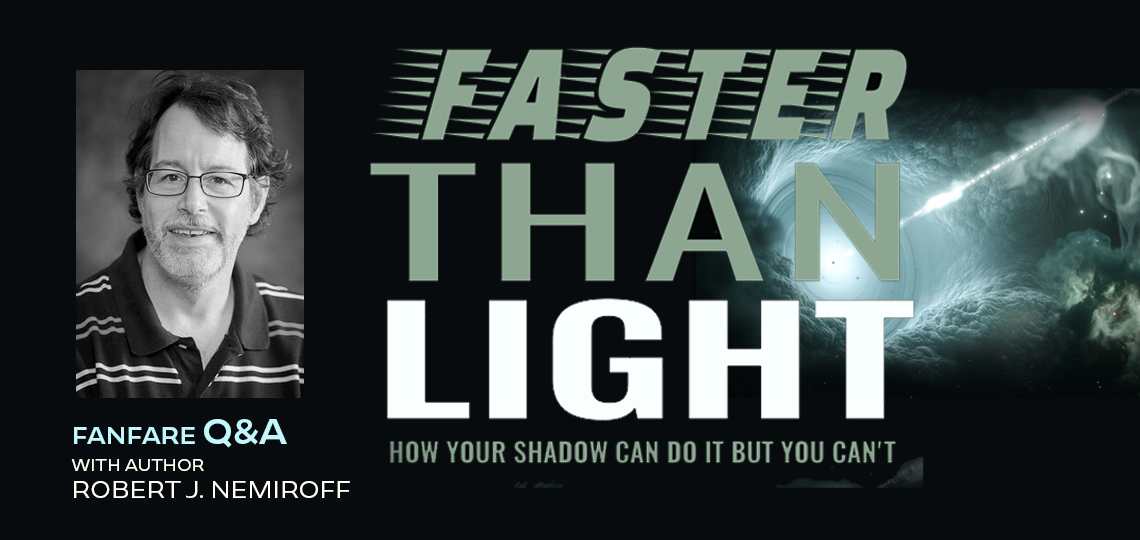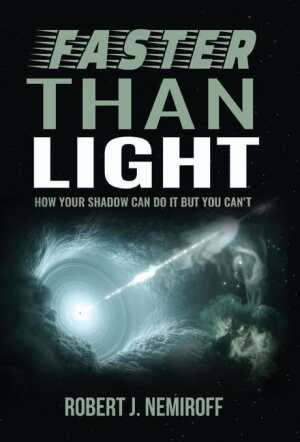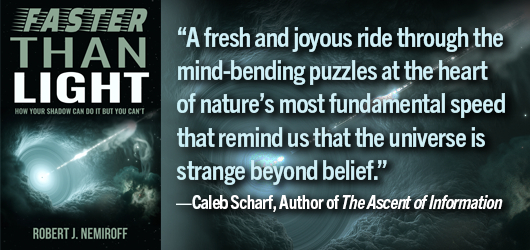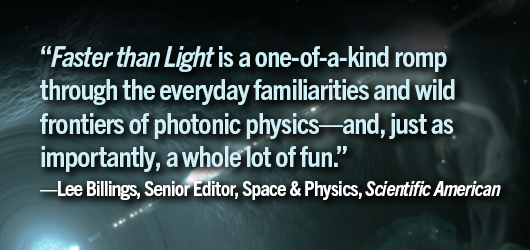A thought-provoking science book from the editor of NASA's Astronomy Picture of the Day

Reviewer Joseph Pete Interviews Robert J. Nemiroff, Author of Faster Than Light: How Your Shadow Can Do It But You Can’t
The speed of light needs no introduction—it’s beyond famous, a marvel of nature, and with its uncontested speed, swaggers around the universe with god-like impunity. We should all be so lucky.
Ahem: Robert Nemiroff would like to add a level of context to SOL’s status. First of all, he says, even Einstein would agree that lots of things can go faster than light. But those things—two lights blinking simultaneously, for example, or shadows—should rightly fall under the realm of illusion, but the blink IS MOVING INFINITELY FASTER THAN LIGHT!
Alright, we’re out there a bit, but there’s a great deal of fun to be had when you let your mind ponder these surrealities, and Robert is exactly the guide we’re looking for. The author of Faster Than Light: How Your Shadow Can Do It But You Can’t, Robert agreed to take some questions from Joseph Pete, reviewer extraordinaire.
Your book explores paradoxes created by the speed of light. Which do you find to be the most mind-bending and why?
First of all, this book is for everyone who likes to think—and laugh. One reason for being granted the opportunity to sit for this interview is that this book received a five-star review from Clarion Foreword, a review that noted both the book’s “thought-provoking science” and its “winsome humor”—right in the first sentence!
Past that, even if you never took any science in high school, you may like this book. That’s because the book assumes little-to-no science background. That said, many of the book’s conceptual questions, which involve no math, will likely challenge everyone, including even the most learned and haughty scientist.
Now, to answer your first question, the most mindbending to me is that anything at all can go faster than light. Saying this seems to imply that I don’t understand basic science, that I think that I have outsmarted Einstein, or that I am just an attention-hungry shill who will say anything for money, but the larger truth is that I have been fascinated by the strange speed limit of light for much of my life. Moreover, I have been practicing explaining this stuff to myself for a long time. And to my eye, this really interesting, simple yet counter-intuitive topic is unsatisfyingly explained everywhere else.
Would Einstein really agree that some things can go faster than light? Surely. Here is a very simple example: Say you have two lights separated by a light year. That means that it takes light itself one year to go from one light to the other. Got it? Now arrange it so that one light blinks one second after the next. It may seem that the “blink” went from one light to the other. If so, then this “blink” traveled between the lights faster than light. In fact, if the two lights blinked at exactly the same time, then the speed that the “blink moved” between the lights was infinitely fast. This is absolutely undeniable. And not in violation of anything that Einstein ever said. This example is sometimes called the Holiday Lights Illusion because if you are bored and staring at blinking holiday lights, it may seem to you that the “blink” can jump between lights. And experience shows that if you point this out to your mother, she will wonder what is wrong with you.
What is deniable is that anything moved at all. And if nothing moved, how can we give it a speed? This blink-jumping is, after all, an illusion. But pretty much all “things” that “move” faster than light are illusions like this. So what is the big deal? Well, it turns out that many familiar “things” are actually illusions like this. Shadows, for example. And laser spots. And the illumination patterns on walls when you turn on a light bulb. And even light reflected from common things—much of the light you really see. And this faster-than-light attribute is non-controversial, explained nowhere, and creates situations that are really fun to think about.
What makes people so adamant on the subject of general relativity and what counterexamples to the immutability of the speed of light should they consider?
People, it seems to me, have pillars of understanding on top of which they build their other understandings. One of these, for many people, is anchored to the phrase that “nothing can go faster than light.” This is true of local material things, as far as Einstein and modern science can tell. But as stated above, it’s just not true for shadows, blinking lights, or other things that are the orchestrated superpositions of unrelated events. For example, when the sun rises, your shadow breaks into two pieces, one of which moves away from you, and the other moves toward you in a familiar way. The part of the shadow moving toward you can move—you guessed it—faster than light. Almost nobody knows this, but it is easily proven true. And Einstein would be fine with it because it does not contradict anything he said, including everything in Special Relativity that gives light’s speed as the limit!
As a physics professor at a research university, what first interested you in this subject?
I like to contemplate things that are both very simple and very strange. For example, sometimes warm water will form ice in your freezer faster than cold water. (Why? Because it can melt nearby ice and then become closer to the floor of your freezer—which is colder than ice.) And the speed of light speed limit has many attributes like this. The speed of light seems to be a simple single number, but I can show you that it can create many strangely counterintuitive things.
You coin the phrase “butterfly reader” to describe flipping through nonfiction books nonsequentially to learn more about what you’re most curious about. How did you come to this method of reading and why would you recommend it? Do you find that it deepens your understanding?
Have you, dear reader, read all of your books from cover to cover? For works of fiction, me too! On the other hand, I don’t usually read nonfiction books this way. Why? Often, there are specific topics or sections I’m eager to explore. For me, nonfiction is not about plot development, but cool things I didn’t know. And so jumping around a nonfiction book, being a butterfly reader, is usually more satisfying for me.
Why do you prefer to use puzzles and thought experiments to teach the concepts of modern physics?
There is a popular movement in teaching math and science of using conceptual questions in class to help the students learn the material. I did not start the movement, but I have been using it for many years to good effect. The premise is simple: mere lecturing can be dull, leading to students tuning out. But challenging them to think and discuss the fundamental concepts at the core of the lecture can be more interesting and effective. These in-class concept questions motivated me to continue this approach in my book. My hope is that these questions are not only more entertaining to contemplate, but lead to a deeper understanding.
Personally, I’ve pondered some of the book’s questions in the back of my mind for years. And I would frequently wonder why some seemingly obvious answers proved ultimately wrong. Now, with this book, I was able to make use of all this background thinking by listing and explaining why these wrong answers are wrong, and why the listed “best answer” is better.
Sometimes, I was even able to include questions whose answers were previously unknown. Over the years of my career, I’ve been fortunate enough to discover their answers, often leading to my publication of peer-reviewed papers on these topics. This uniqueness of the book stems from its inclusion of information never before published at a popular level. Now true, my published papers have math, but they are rooted in concepts where no math is needed, and in the book my focus is solely on the fascinating underlying concepts.
What inspires the comic relief answers in your multiple-choice questions? Is there really no amount of beers you can drink to swing the far end of a long, straight pole faster than the speed of light?
Comedy is a currency in my house. If you can make another family member laugh, you’ve enriched them—and proven your wit. The competition has been steep: my daughter is now part of a TikTok comedy group (https://www.tiktok.com/@tinyideastuff) and has written comedy for a YouTube science star who you are now hoping I will name but I won’t. Also, when my wife was growing up, her visiting relatives used to bring a change of underwear because she could make them laugh so hard they would soil themselves. I am not making this up. Today, I try my best to leverage this home-practiced humor into my classes when I teach, once even to good effect. And now some of it has leaked into this book!
Surprisingly, you are not the first to cite that beer-swinging question as particularly humorous. Although grateful, in truth I am really waiting to receive a compliment on the dancing zebra question later in the book.
If objects with mass are bound to the speed of light, why contemplate exceptions without mass?
Because I really don’t believe that massive objects can pass by moving faster than light. One of the surprising things about the book is that it is not crazy woo. The universe is already crazy in ways that do not involve woo. That’s what I try to focus on in this book.
What reading would you recommend to explore your book’s subjects further?
There’s a wealth of excellent science books out there. I suggest works by Feynman, Greene, Hossenfelder, Plait, Sagan, Scharf, Trimble, and Tyson, to name a few.
What are you working on next?
Interestingly, what I am working on next is exactly what I was working on before. This also happens to be the science writing I’m most recognized for because it is for one of NASA’s most popular science websites: the Astronomy Picture of the Day (APOD: https://apod.nasa.gov/). APOD has been running since 1995 and now receives over a million page views every day. Surprisingly, I am finding that many book readers just weren’t aware of my continuing involvement with APOD. In reality, I’m not just a creator and editor; I’m also its lead writer!
Oh, and past that, I do have at least one more book in mind.
FASTER THAN LIGHT
HOW YOUR SHADOW CAN DO IT BUT YOU CAN’T
Clarion Rating: 5 out of 5
The thought-provoking science book Faster than Light unpacks the conceptual riddles surrounding the speed of light with winsome humor.
Robert J. Nemiroff’s enlightening popular science book Faster than Light probes the mind-bending implications of a universal constant.

Albert Einstein’s theory of the constant speed of light, Nemiroff says, can result in paradoxes, on both a quantum mechanics level and a cosmological scale. To address these, his book breaks down advanced scientific concepts in straightforward, direct terms, using specialized nomenclature in a sparing and accessible way. Across broad topical sections covering Earth, the universe, and relativity and communications, the chapters focus on subjects including superluminal history, improving light bulbs, and increasing the speed of laser spots. Each is detailed in covering both historical experiments and advanced ideas well, moving through dense concepts with systematic awareness and sharing digestible analogies to aid understanding, as when photon wave packets are compared to a locomotive-led train.
Aimed at the general public, the book focuses on ideas rather than particular math and data. Its scenarios are abstract but relatable. Multiple-choice quizzes are included at frequent intervals to help the audience check in with their developing understandings of the subjects—often including joking answers, like that it would be possible to take a train that moves away from the station faster than light in theory, but in practice the ticket would be too expensive.
Indeed, jokes are frequent in the text, humanizing the cerebral subject matter. Some are riffs, as with the juxtaposition of theories of quantum mechanics to theories of car mechanics. Others are more offbeat, as with a hypothetical question about whether someone could swing a long, straight pole around after a few beers and make it go faster than light; it quips, “It sure seems possible to create a sonic boom with a lit candle and a long piece of string, for the life of me I can’t figure out how.” These qualities help to make it both a classroom and a playground. Whimsical drawings further elucidate the concepts, illustrating the book’s suppositions well.
The book develops its observations far beyond the observable universe, coming to a fitting halt when it reaches a theory so esoteric that it led Einstein to stop in his tracks in the middle of the road to contemplate it. Encouraging further contemplation of the universe’s mysteries, the thought-provoking science book Faster than Light unpacks the conceptual riddles surrounding the speed of light with winsome humor.
Reviewed by Joseph S. Pete
Joseph S. Pete



